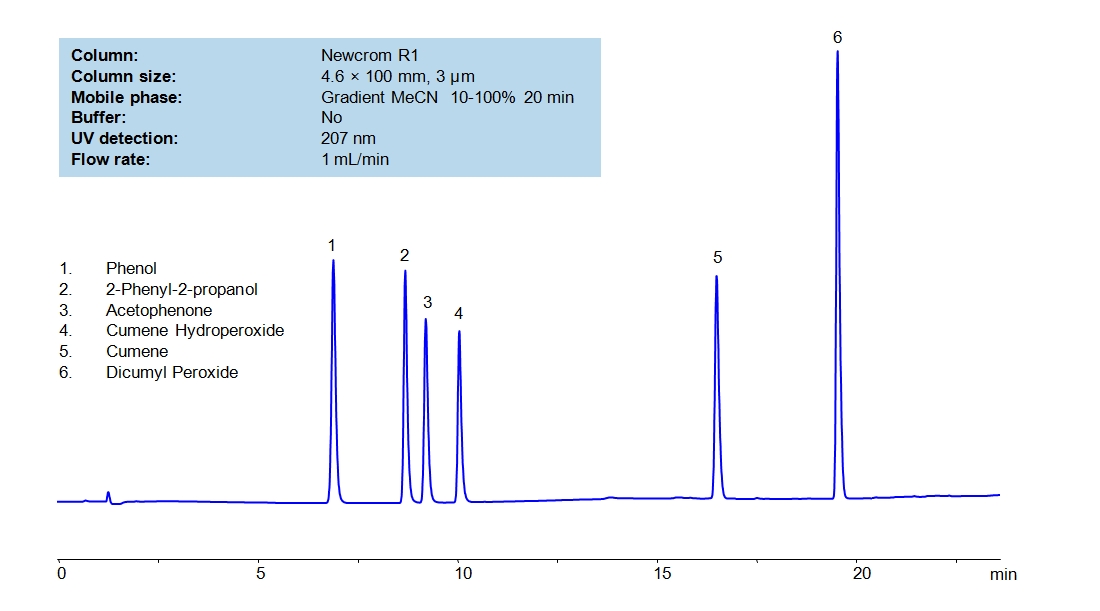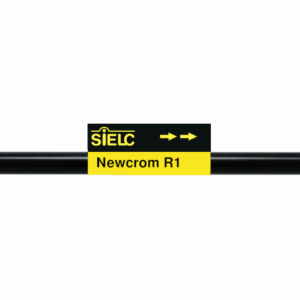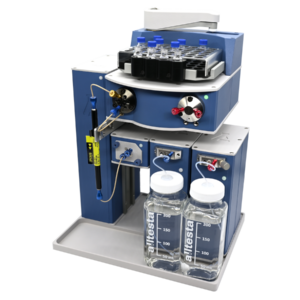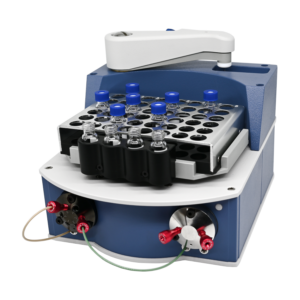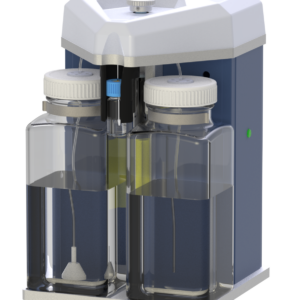HPLC method for Phenol – Acetone production and impurities
High Performance Liquid Chromatography (HPLC) Method for Analysis of Phenol, 2-Phenyl-propanol, Acetophenone, Cumene Hydroperoxide, Cumene, Dicumyl Peroxide
Phenol is an organic compound with the molecular formula C6H5OH.
Properties: Appearance: Typically white crystals that turn a light pink due to oxidation.
Molecular weight: ~94.11 g/mol
Solubility: Soluble in water and alcohol.
Uses: Topical skin disinfectant.
2-Phenyl-propanol is an organic compound with the molecular formula C9H12O.
Properties: Appearance: Typically a white or yellow odorless solid.
Molecular weight: ~136.19 g/mol
Solubility: Soluble in organic solvents.
Uses: Organic synthesis.
Acetophenone is an aromatic ketone with the molecular formula C6H5COCH3.
Properties: Appearance: Typically a colorless or yellow liquid with a pungent odor.
Molecular weight: ~120.4 g/mol
Solubility: Soluble in organic solvents.
Uses: Fragrance ingredient.
Cumene Hydroperoxide is an organic compound with the molecular formula C9H12O2.
Properties: Appearance: Typically a colorless or yellow liquid with a pungent odor.
Molecular weight: ~152.19 g/mol
Solubility: Soluble in organic solvents.
Uses: Used in production of phenol and acetone.
Cumene is a hydrocarbon with the molecular formula C9H12.
Properties: Appearance: Typically a colorless liquid with a pungent odor.
Molecular weight: ~120.19 g/mol
Solubility: Soluble in organic solvents.
Uses: Used in production of phenol and acetone.
Dicumyl Peroxide is a organic peroxide with the molecular formula C18H22O2.
Properties: Appearance: Typically white crystals.
Molecular weight: ~270.37 g/mol
Solubility: Soluble in organic solvents.
Uses: Used in production of rubber and plastics. Phenol, 2-Phenyl-propanol, Acetophenone, Cumene Hydroperoxide, Cumene, and Dicumyl Peroxide can be retained and analyzed using the Newcrom R1 stationary phase column. The analysis utilizes an gradient method with a simple mobile phase consisting of water, acetonitrile (MeCN). Detection is performed using UV.
Phenol, 2-Phenyl-propanol, Acetophenone, Cumene Hydroperoxide, Cumene, Dicumyl Peroxide can be retained and analyzed using the Newcrom R1 stationary phase column. The analysis utilizes a gradient method with a simple mobile phase consisting of water, acetonitrile (MeCN). Detection is performed using UV.
| Column | Newcrom R1, 4.6 x 100 mm, 3 µm, 100 A, dual ended |
| Mobile Phase | Gradient MeCN – 10-100%, 20 min |
| Buffer | No |
| Flow Rate | 1.0 ml/min |
| Detection | UV, 207 nm |
| Class of Compounds |
Neutral, Basic, Hydrophobic |
| Analyzing Compounds | Acetophenone, Dicumyl peroxide, Cumene hydroperoxide, Cumene, Phenol |
Application Column
Newcrom R1
Column Diameter: 4.6 mm
Column Length: 100 mm
Particle Size: 3 µm
Pore Size: 100 A
Column options: dual ended
Cumene
Cumene hydroperoxide
Dicumyl peroxide
Phenol

